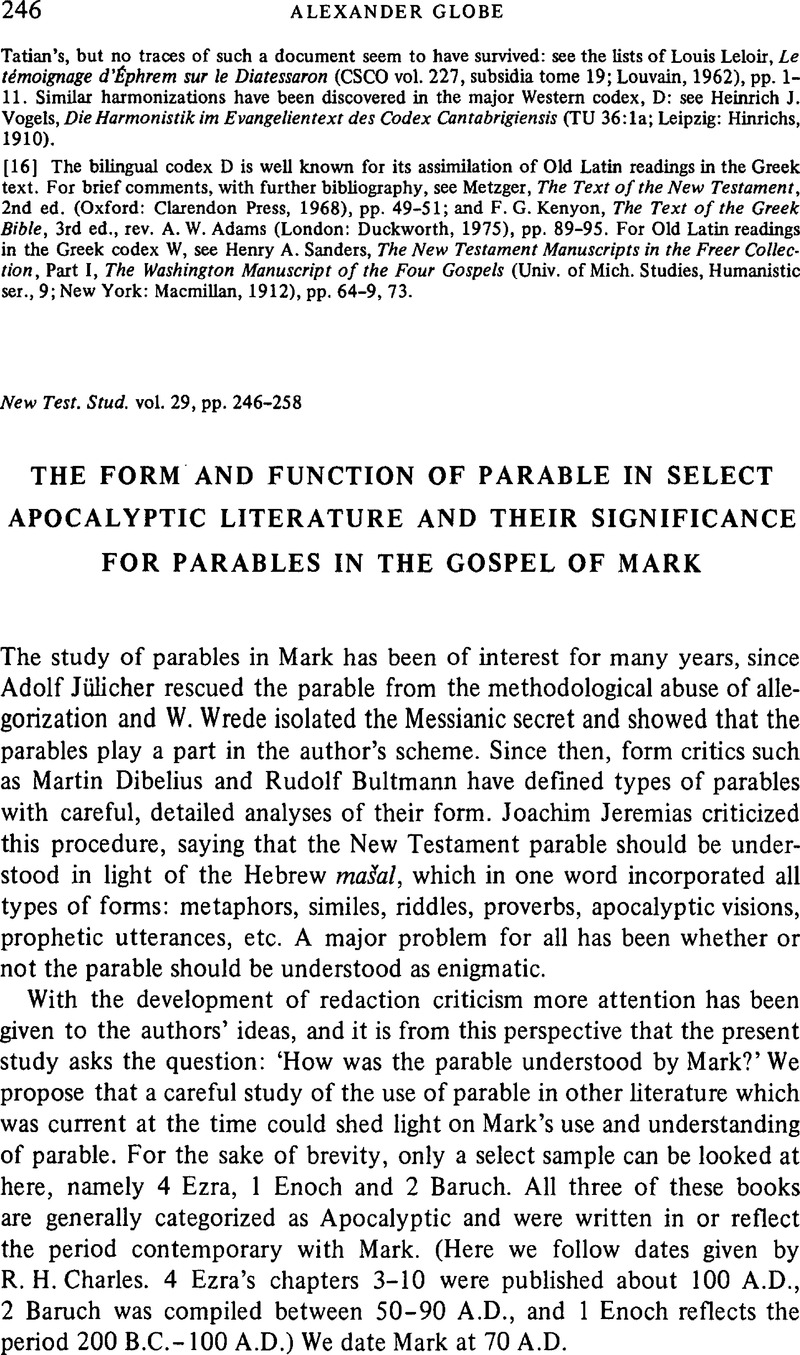Published online by Cambridge University Press: 05 February 2009

[1] Charles, Robert H., The Apocrypha and Pseudepigrapha of the Old Testament, Vol. 2 (Oxford, 1913), p. 568.Google Scholar
[2] Cf. Numbers 24. 3, 4 where Balaam took up his ‘parable’ referring to a prophetic discourse. Charles, op. cit., p. 188.
[3] Cf. Numbers 32. 7, 18; Job 27. 1 that are elaborate discourses in the forms of visions, prophecy, or poems. Charles, op. cit., p. 188.
[4] Apparently some of the third parable has been lost to make room for the Noahic fragments. As it stands, the third parable consists of chapters 58, 61, 64, 69. 26. For our purpose, however, we will include the Noahic fragments in our sketch of the forms included in the third parable since we are concerned with the final draft of the book 1 Enoch.
[5] TeSelle, Sallie, Speaking in Parables (Philadelphia, 1975), p. 67.Google Scholar
[6] Dibelius, Martin, Die Form geschichte des Evangeliums (Tübingen, 1959), translated by Wolf, Bertram Lee, ET: From Tradition to Gospel (London, 1934), pp. 236–7.Google Scholar
[7] Lane, William L., Commentary on the Gospel of Mark (Grand Rapids, Mich., 1974), p. 149Google Scholar; Ridderbos, Herman, The Coming of the Kingdom (Philadelphia, 1962), pp. 121–9Google Scholar; Burkill, T. Alec, Mysterious Revelation: An Examination of the Philosophy of St. Mark's Gospel (Ithaca, New York, 1963), p. 97.Google Scholar
[8] Cf. Dibelius, op. cit., p. 47.
[9] Lane, op. cit., pp. 152–3.
[10] Marxsen, Willi, ‘Redaktiongeschichte Erklärung der sogennanten Parabeltheorie des Markus’, Z.T.K. 52 (1955), p. 267Google Scholar, says that by altering ‘parable’ to the plural in Mark 4. 10, the message of this one parable becomes a paradigm for preaching generally; see Lane, op. cit., p. 156.
[11] Carlston, Charles E., The Parables of the Triple Tradition (Philadelphia, 1975), p. 98.Google Scholar
[12] Ibid. p. 99.
[13] Jeremias, Joachim, Die Gleichnisse Jesu (Berlin, 1956), translated by Hooke, S. H., ET: The Parables of Jesus (New York, 1963), pp. 17–18Google Scholar; Taylor, Vincent, The Gospel According to Mark (London, 1952), p. 255Google Scholar; cf. Manson, Thomas W., The Teaching of Jesus (Cambridge, 1963), pp. 77–80.Google Scholar
[14] Boobyer, George H., ‘The Redaction of Mark IV, 1–34’, N.T.S. 8 (1961–1962), pp. 61–2.Google Scholar
[15] Robinson, James, The Problem of History in Mark (London, 1957), p. 49.Google Scholar
[16] Bousset, Wilhelm, Kyrios Christos (New York-Nashville, 1970), p. 108.Google Scholar
[17] Jeremias, op. cit., p. 16.
[18] Burkill, T. Alec, ‘The Cryptology of Parables in St. Mark's Gospel’, N.T. 1 (1956), p. 249.Google Scholar
[19] Via, Dan Otto, The Parables (Philadelphia, 1974), pp. 8, 10Google Scholar; also Bousset, op. cit., p. 108, says that this tendency begins as far back as chapter three, where Jesus begins: see also the insertion of the throngs of people (3. 7–12), the meeting of the disciples (3. 13–19) and the separation from relatives (3. 20–21, 21–35). Already he had set himself and the disciples apart from the rest of the people.